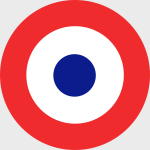Corgi AA37908 French SPAD XIII Fighter - S7000, Rene Fonck, Escadrille 103, Autumn 1918 (1:48 Scale)
"I put my bullets into the target as if I placed them there by hand."
- Rene Fonck
 The Societe Pour L'Aviation et ses Derivas, commonly known as SPAD, was a French aircraft manufacturer responsible for producing a number of significant fighter aircraft during the First World War. Originally called Societe de production des avions Deperdussin, the company was virtually bankrupt before the war when it was rescued by Louis Bleriot who changed the name while retaining the initials.
The Societe Pour L'Aviation et ses Derivas, commonly known as SPAD, was a French aircraft manufacturer responsible for producing a number of significant fighter aircraft during the First World War. Originally called Societe de production des avions Deperdussin, the company was virtually bankrupt before the war when it was rescued by Louis Bleriot who changed the name while retaining the initials.
SPAD began by building the "A-series" of pusher two-seat biplanes. In early 1915 SPAD began development of a tractor biplane designated the "S.V" which went into production as the SPAD S.VII. Improvements in the S.VII led first to the S.XII and then to the development of the definitive SPAD fighter, the S.XIII which entered service in May 1917 and equipped French, British and American squadrons. Over 8,000 S.XIIIs were eventually built.
The SPAD was most notably flown in service by Count Francesco Baracca and Capt. Eddie Rickenbacker, two of the Entente highest scoring aces of WWI with 34 and 26 victories respectively. It was also flown by most French aces, including Georges Guynemer, one of France's most popular pilots.
Pictured here is a 1:48 scale replica of a SPAD XIII fighter flown by Rene Fonck, who was attached to Escadrille 103 during the Autumn months of 1918. Sold Out!
Dimensions:
Length: 5-1/4-inches
Wingspan: 6-3/4-inches
Release Date: September 2019
 Historical Account: "Ace of Aces" - Although history has dictated that the aerial combat prowess of Manfred von Richthofen ensured he became one of the world's most famous aviation personalities, the same cannot be said of the leading Allied "Ace of Aces" from the Great War, who has remained largely anonymous to all but the most committed of enthusiasts. Rene Fonck originally shunned the opportunity to become a pilot, preferring instead to share the trenches with his countrymen, as they fought against the Germans. The horrors of war soon changed his mind and led him to the cockpit of an airplane, where he was to display a real aptitude for flying and would eventually see him posted to a French Air Force reconnaissance squadron. His impressive airmanship and determination to fight brought about a transfer to the elite Escadrille 103 and the beginning of a long association with the SPAD fighter, an aircraft in which he would quickly begin to score victories.
Historical Account: "Ace of Aces" - Although history has dictated that the aerial combat prowess of Manfred von Richthofen ensured he became one of the world's most famous aviation personalities, the same cannot be said of the leading Allied "Ace of Aces" from the Great War, who has remained largely anonymous to all but the most committed of enthusiasts. Rene Fonck originally shunned the opportunity to become a pilot, preferring instead to share the trenches with his countrymen, as they fought against the Germans. The horrors of war soon changed his mind and led him to the cockpit of an airplane, where he was to display a real aptitude for flying and would eventually see him posted to a French Air Force reconnaissance squadron. His impressive airmanship and determination to fight brought about a transfer to the elite Escadrille 103 and the beginning of a long association with the SPAD fighter, an aircraft in which he would quickly begin to score victories.
The consummate tactician, Fonck would study the actions of his enemy during combat, watching from a safe distance before decisively launching his attack. Using as little ammunition as possible and perfecting the art of deflection shooting, Fonck would boast that he could direct his bullets so precisely into an enemy aircraft that it was as if he had placed them there by hand. By the end of the war, Fonck had been credited with 75 aerial victories, although his actual total is thought to have been much higher, possibly as many as 100 and even eclipsing the great Red Baron. As it was, his official score made him second only to von Richthofen, the Allied "ace of aces" and the highest scoring fighter ace to survive the war.


